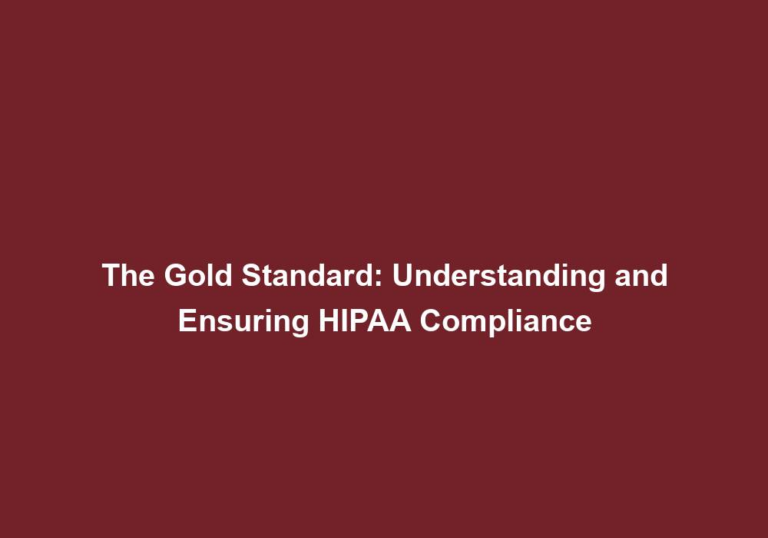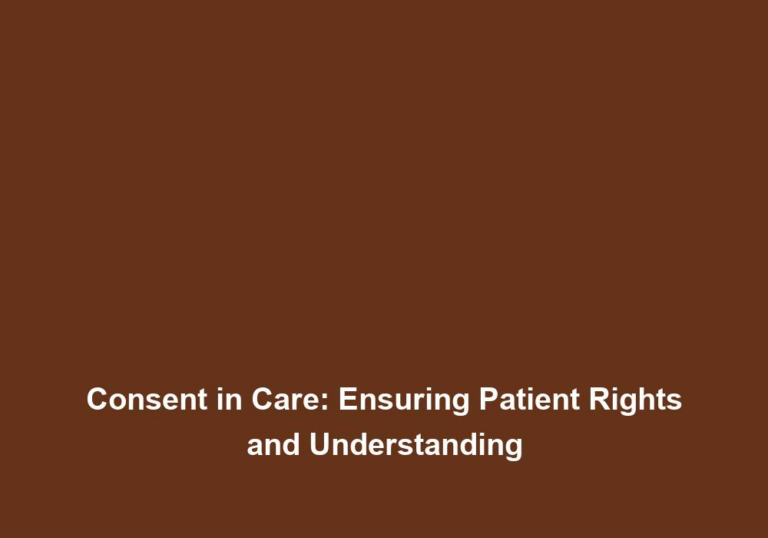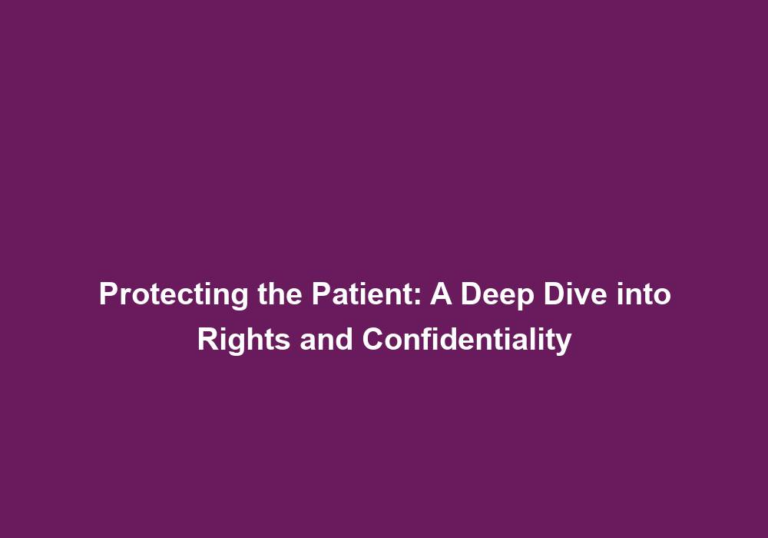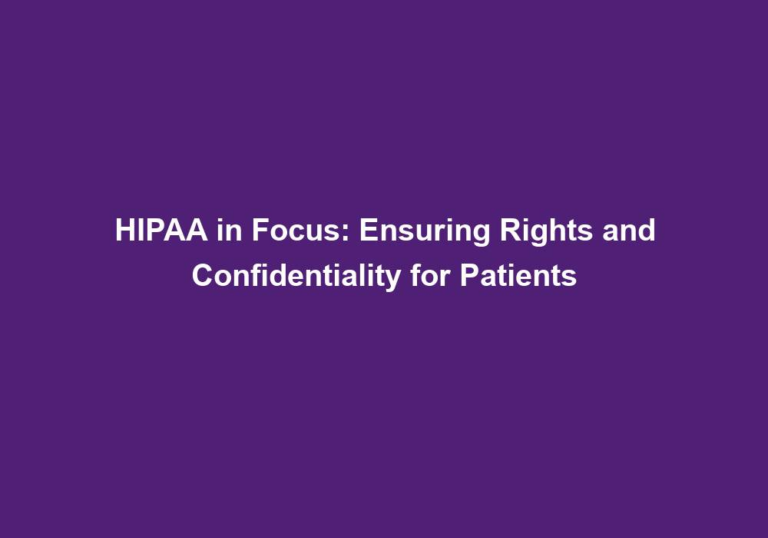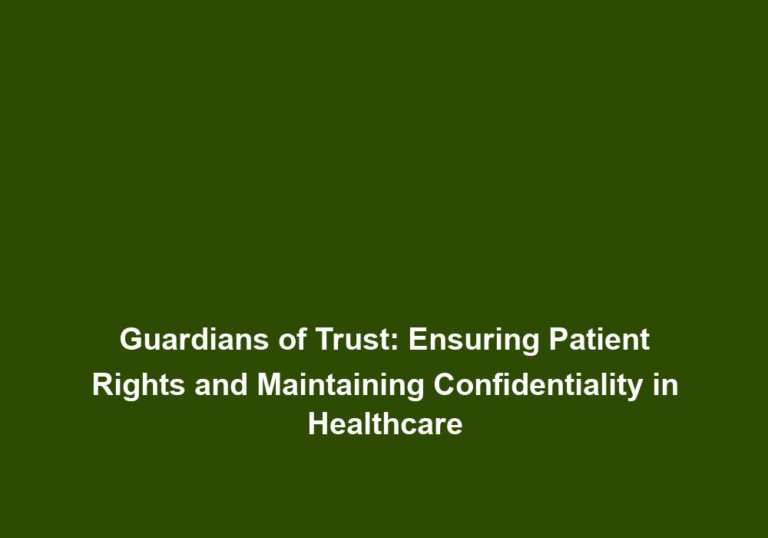From Informed to Empowered: Mastering Patient Consent Procedures
In the ever-evolving landscape of healthcare, patient consent procedures hold paramount importance. The shift from a traditional informed consent model to a more patient-centric approach has transformed the way healthcare professionals engage with their patients. This article aims to explore the concept of patient consent, its evolution, and the significance of empowering patients through effective communication and shared decision-making.
Understanding Patient Consent
Patient consent refers to the process by which healthcare providers inform patients about the potential risks, benefits, and alternatives of a proposed medical intervention. It ensures that patients have a thorough understanding of their medical condition, treatment options, and potential consequences before making an informed decision.
Patient consent is a vital aspect of healthcare that allows patients to have control over their own medical decisions. It involves healthcare providers explaining the details of a medical intervention to patients, including the potential risks and benefits. This process ensures that patients are well-informed and have a clear understanding of their treatment options.
The Evolution of Informed Consent
The concept of informed consent has its roots in medical ethics, dating back to the mid-20th century. Initially, it primarily focused on providing patients with relevant information, enabling them to make autonomous decisions. However, with advancements in medical technology, the landscape of healthcare became more complex, necessitating a shift towards a more patient-centric approach.
- Moving from Information to Empowerment: Today, patient consent procedures aim to empower patients with a comprehensive understanding of their health condition, treatment options, and potential outcomes. It goes beyond simply providing information and focuses on fostering a collaborative partnership between patients and healthcare providers.
The evolution of patient consent procedures has seen a transition from providing mere information to empowering patients with knowledge and understanding. It is no longer sufficient to solely inform patients about their condition and treatment options. Healthcare providers now strive to empower patients by ensuring they have a comprehensive understanding of their healthcare journey. This includes discussing the potential outcomes of different treatment options, providing them with the necessary tools to actively participate in their own care.
- Shared Decision-Making: The emergence of shared decision-making has transformed patient consent procedures. It emphasizes involving patients in the decision-making process by considering their values, preferences, and personal circumstances. Shared decision-making not only enhances patient satisfaction but also leads to improved treatment outcomes.
Shared decision-making is a collaborative approach that involves healthcare providers and patients working together to make informed decisions. It takes into account the patient’s values, preferences, and personal circumstances, allowing them to actively participate in their healthcare journey. This approach not only improves patient satisfaction but also leads to better treatment outcomes as patients are more likely to adhere to their chosen treatment plan.
- Legal and Ethical Frameworks: The evolution of patient consent procedures has been influenced by legal and ethical frameworks. Various jurisdictions have enacted laws and regulations to ensure that patients’ rights are protected, and healthcare providers adhere to ethical standards. These frameworks emphasize the importance of transparency, respect for autonomy, and effective communication.
Legal and ethical frameworks play a crucial role in shaping patient consent procedures. They provide guidelines and regulations that healthcare providers must adhere to when obtaining patient consent. These frameworks prioritize transparency, ensuring that patients are fully informed about their healthcare decisions. They also emphasize the respect for patient autonomy, recognizing the importance of patients having the right to make decisions about their own healthcare.
Empowering Patients through Effective Communication
Effective communication lies at the heart of empowering patients during the consent process. By employing clear, concise, and jargon-free language, healthcare providers can facilitate understanding and foster trust with their patients. Here are some key strategies for effective communication during patient consent:
- Active Listening: Active listening involves attentively hearing and understanding the patient’s concerns, questions, and preferences. It allows healthcare providers to address any uncertainties, build rapport, and establish a collaborative relationship.
Active listening is a crucial aspect of effective communication during the consent process. It involves healthcare providers actively engaging with patients, listening attentively to their concerns, questions, and preferences. This not only helps healthcare providers address any uncertainties or fears the patient may have but also allows them to build rapport and establish a collaborative relationship based on trust.
- Plain Language: Healthcare professionals should avoid using complex medical terminology and instead use plain language to ensure patients comprehend the information being conveyed. This helps bridge the gap between medical expertise and patient understanding.
Using plain language is essential to ensure effective communication during patient consent. Healthcare professionals must avoid using complex medical terminology that may confuse or overwhelm patients. Instead, they should use simple and clear language to convey information in a way that patients can easily understand. This helps bridge the gap between medical expertise and patient understanding, ensuring that patients are fully informed and able to make informed decisions about their healthcare.
- Visual Aids and Written Material: Visual aids, such as diagrams, charts, and videos, can enhance patient comprehension by presenting information in a more accessible format. Written materials, such as brochures or pamphlets, can also serve as valuable resources for patients to review at their convenience.
Visual aids and written materials are valuable tools to enhance patient comprehension during the consent process. Visual aids, such as diagrams, charts, and videos, can help patients visualize complex medical concepts, making it easier for them to grasp the information being conveyed. Written materials, such as brochures or pamphlets, can serve as supplementary resources that patients can review at their own pace, reinforcing their understanding of the treatment options and potential outcomes.
- Ask and Encourage Questions: Healthcare providers should actively encourage patients to ask questions and address any doubts they may have. This promotes a collaborative environment and ensures that patients feel empowered to actively participate in their care.
Encouraging patients to ask questions and address any doubts they may have is crucial for effective communication during the consent process. Healthcare providers should create a safe and supportive environment where patients feel comfortable asking questions and seeking clarification. This promotes a collaborative relationship and empowers patients to actively participate in their own care, leading to better treatment outcomes.
The Role of Technology in Patient Consent
Technology has had a profound impact on patient consent procedures, enabling healthcare providers to deliver information in innovative ways and enhance patient engagement. Here are some ways in which technology has transformed the consent process:
- Electronic Consent Forms: Electronic consent forms have replaced traditional paper-based forms, streamlining the consent process and reducing administrative burdens. They allow patients to review, sign, and store their consent electronically, improving efficiency and accessibility.
The advent of electronic consent forms has revolutionized the consent process. Electronic forms have replaced traditional paper-based forms, making the consent process more efficient and reducing administrative burdens. Patients can review, sign, and store their consent electronically, eliminating the need for physical paperwork. This not only saves time but also improves accessibility and ensures that consent documents are securely stored and easily accessible when needed.
- Interactive Educational Tools: Technology has facilitated the development of interactive educational tools, such as online videos, mobile applications, and virtual reality experiences. These tools enable patients to explore their treatment options visually, gaining a deeper understanding of the procedure and its potential outcomes.
Interactive educational tools have significantly enhanced patient engagement and understanding during the consent process. Online videos, mobile applications, and virtual reality experiences provide patients with interactive and immersive experiences that allow them to explore their treatment options visually. This not only helps patients gain a deeper understanding of the procedure but also enables them to make more informed decisions about their healthcare.
- Remote Consent: Telehealth and remote patient monitoring have become increasingly prevalent, especially in light of the COVID-19 pandemic. These technologies allow healthcare providers to obtain patient consent remotely, ensuring continuity of care while minimizing the need for in-person interactions.
The COVID-19 pandemic has accelerated the adoption of telehealth and remote patient monitoring, making remote consent a viable option for many healthcare providers. Telehealth enables healthcare providers to conduct consultations and obtain patient consent remotely, ensuring continuity of care while minimizing the need for in-person interactions. This not only improves accessibility to healthcare services but also reduces potential exposure to infectious diseases, enhancing patient safety.
Ensuring Ethical and Legal Compliance
Healthcare providers must navigate complex ethical and legal considerations when implementing patient consent procedures. Adhering to these principles fosters trust, safeguards patient rights, and ensures the ethical conduct of healthcare professionals. Some essential considerations include:
- Informed Consent Documentation: Healthcare providers should maintain comprehensive records of the consent process, including the information provided, patient questions, and any modifications made. This documentation serves as evidence of a thorough consent process and protects both patients and healthcare providers.
Maintaining comprehensive documentation of the consent process is essential for ethical and legal compliance. Healthcare providers should document the information provided to patients, any questions or concerns raised by patients, and any modifications made to the treatment plan. This documentation serves as evidence of a thorough consent process and protects both patients and healthcare providers in case of any legal disputes.
- Respecting Autonomy: Respecting patient autonomy is fundamental in the consent process. Healthcare providers should acknowledge the right of patients to make informed decisions about their own healthcare, even if their choices differ from the healthcare provider’s recommendation.
Respecting patient autonomy is a fundamental ethical principle in the consent process. Healthcare providers should acknowledge that patients have the right to make decisions about their own healthcare, even if their choices differ from the healthcare provider’s recommendation. It is important to ensure that patients are fully informed about the potential risks and benefits of different treatment options, allowing them to make decisions that align with their values and preferences.
- Consent for Minors and Vulnerable Populations: Special considerations must be made when obtaining consent from minors and vulnerable populations, such as individuals with cognitive impairments or language barriers. In such cases, healthcare providers may need to involve family members, interpreters, or legal representatives to ensure that informed decisions are made.
Obtaining consent from minors and vulnerable populations requires special considerations to protect their rights and well-being. Healthcare providers must ensure that individuals with cognitive impairments or language barriers are provided with the necessary support to make informed decisions. This may involve involving family members, interpreters, or legal representatives to facilitate the consent process and ensure that the individual’s best interests are upheld.
Conclusion
Mastering patient consent procedures involves embracing a patient-centric approach, effective communication, and shared decision-making. Empowering patients by providing comprehensive information, fostering collaboration, and respecting their autonomy can enhance patient satisfaction, improve treatment outcomes, and ultimately lead to a more patient-centered healthcare system. As healthcare professionals, it is our responsibility to continuously evolve our practices and ensure that patient consent remains an integral part of quality care delivery.
Note: This article has been generated by OpenAI’s GPT-3 language model, and while efforts have been made to provide accurate and reliable information, it should not be considered as professional medical or legal advice. It is always recommended to consult with qualified healthcare professionals or legal experts for specific concerns or inquiries.



